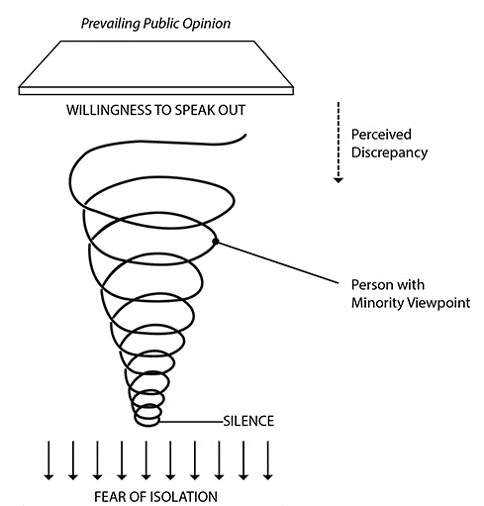Spiral of Silence Theory
To avoid being isolated from society, an individual can decide to no longer think for himself and set aside his judgment (Noelle-Neumann, 1991).
To affirm this, the author of the theory of the Spiral of Silence is based on the existence of processes of formation of public opinion (Allport, 1937). Indeed, the interaction between individuals and their social environment generates a mass opinion (Asch, 1951; Milgram, 1961). All this leads to a fear of isolation coupled with doubt about one's own capacity for judgment, which stems from the processes of public opinion, as the author confirms.
Noelle-Neumann (1991) schematically theorizes her thought through a "spiral" of silence, which shows that public opinion corresponds to that which can be expressed in public without taking the risk of being isolated from the debates. Thus, its apparent sanction, the individuals will speak more easily since it will express the thought of the mass. If the individual wishes to address a vision opposed to that of public opinion, the latter is forced into silence (Tönnies, 1922). Part of the population is thus forced to remain silent because they feel inferior (Bryce, 1924).

Figure 1: Diagram of the Spiral of Silence (Noelle-Neumann, 1991)
The spiral drawn by the author presents the majority opinion at the top of the platform. The particularity is that the majority thought can descend further down the spiral and become a minority afterwards. This leads a majority opinion to fall into silence. The factors for achieving silence are the dissemination of opinion by the mass media, as the author specifies. During the 1948 presidential elections in the Federal Republic of Germany, the majority opinion changed to give way to the minority opinion (McDonald et al., 2001). These authors also specify that the reason for this is that minority opinion has been much more present in the mass media, which has allowed individuals who have remained silent until then to express themselves fully. In 1980 in the United States the same pattern was repeated during the presidential election (Glynn & Mcleod, 1984).
However, this theory is questioned because of inconsistent results reported several years later (Scheufle & Moy, 2000). These authors specify the existence of conceptual problems, measures of variables of the public opinion process and concerning differences in the level of attention given to macroscopic tests. Indeed, the authors show that some individuals wait to see which opinion will become the majority in the future in order to be able to avoid isolation each time.
We therefore notice that some anticipate future opinions, while others are influenced by society. We are talking about social influence (Shanahan et al., 2009). The agreement or rejection of the other influences the opinion of the individual. Their study on smoking shows that despite prevention and social prohibitions, individuals continue to smoke. Some individuals will be pushed to quit by their social environment (family, friend), while others will be guided more by their own opinion, repressing societal opinions and advocating their individual freedom. In this case, social codes will be created around tobacco consumption, such as taking a break at work to go smoke with colleagues. What is interesting here is the parallel that can be made with any kind of consumption or habit that individuals retain and present freely.
Thus, we notice that despite the fear of isolation, individuals tend to stand out for their originality of thought and their individuality (McDonald et al., 2001). All without worrying about the isolation and silence required by the theory of the spiral of silence.
Nevertheless, the spiral of silence remains a criticism to visualize the impact of mass media on public opinion (Noelle-Neumann, 1991). Societal questions are raised by the author: what are the different ideas advocated by the mass media and when are they put forward? Should we question the power of these media on public opinion? And finally, is conferring such powerful power on a minority of individuals responsible for choosing the information transmitted by these mass media just and democratic?